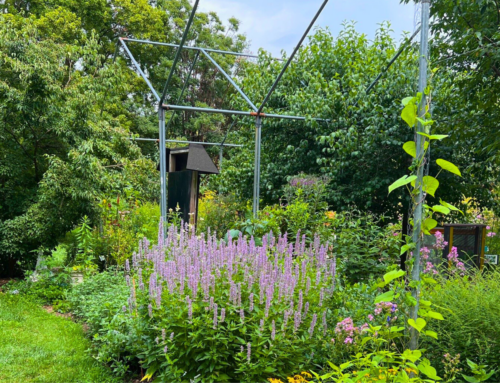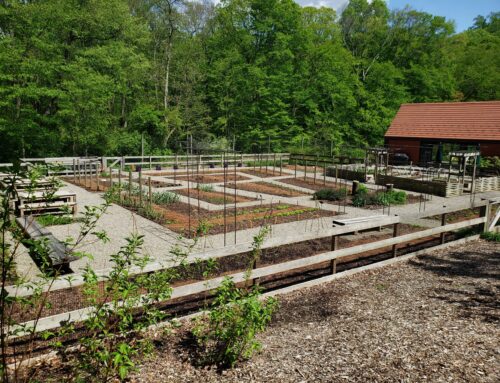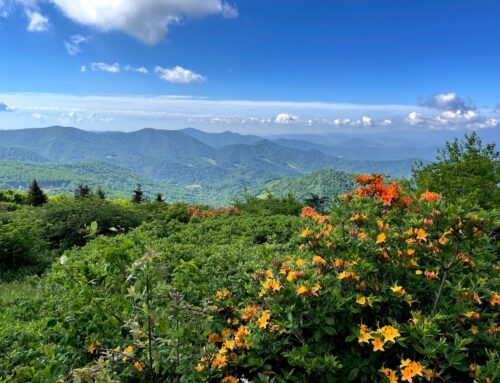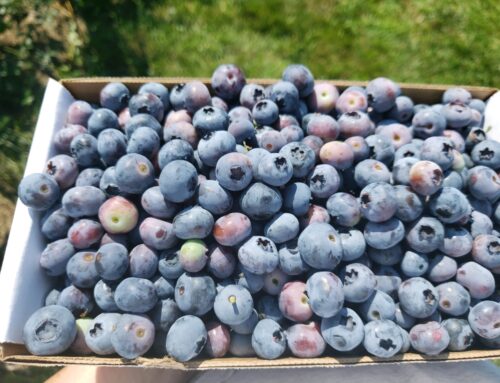In our recent blog Our Changing Community, we talked about how the ecosystems around us have changed during the industrial revolution – and the direct role we’ve played in those changes. We also imagined what it might be like to work towards changing them again as we take action to combat Climate Change and declining biodiversity a little bit closer to the natural cycles that exist all around us.
I know what you’re thinking. That sounds great – but how?
The ecology of Southeastern Pennsylvania doesn’t begin or end with plants, but they are an important part of the story. Without the plants that shape our landscape, we have nothing — no food, no shade, no soil, no birds, bees or butterflies.
I think we all want to build paradise, but what if we did so for ourselves and also the plants, animals and insects who live here too? The good news about plants is that anyone can plant them. Anyone…whether you have a restored forest or meadow, a backyard garden or a container on a porch. We all have the power to get a plant and some soil and make the world a better place simply by combining them and adding water.
Maybe paradise isn’t something you build. Maybe it’s something you grow.
So how do you know what to plant? You look to the fields, forests, meadows and prairies to see what you can learn. You watch the insects, notice what plants they visit, and which they do not. You listen to the birds, to hear where they make their nests. Anyone can do this, at Tyler or in their own yard. But let’s take a moment to share some of the things the scientific community has learned from years of closely watching and listening.
The predominant habitat in Southeastern Pennsylvania is temperate deciduous woodland. In particular, we live in the Oak-Hickory band. What does that mean? It means that Oaks, trees in the genus Quercus, are one of the keystone species of our plant community. So what can we learn from oaks? Oaks support more life forms than any other North American tree genus. Nearly 900 species of caterpillars rely on them, and the benefits to the ecosystem flow upward from there. Birds will spend longer foraging in oaks than in any other tree genera, likely because of the density of caterpillars. One oak, over the course of its lifetime, can produce up to three million acorns – an absolute treasure trove of nutrition. And of all the acorns, white oak acorns are lower in tannins, which makes them slightly less bitter. Wildlife, from squirrels to bears, seem to prefer this sweeter taste. A mature oak tree can also drop up to 700,000 leaves in the autumn, and their slower decomposition means that the leaf litter of oaks can support millions of invertebrates. If you’re a gardener struggling with invasive stilt grass (Microstegium vimineum) or Japanese jumping worm, both species do poorly when oak leaves are present.
That’s not the only benefit they provide, from a human perspective. Oaks have always had a special place in our hearts. We love them for their size and spread. Oaks can grow to be 80 feet tall and equally wide. They are long-lived as well; oaks can live to be up to 300 years old. They can tolerate drought, poor rocky soil and even urban conditions where they make a good street tree. If you give them room to grow and spread, they will become majestic specimens. For a good example of oaks at Tyler, cross over Rocky Run, beyond the Barn Field, and you’ll find two special trees growing along the stream in an area we call ‘The Hollow’.
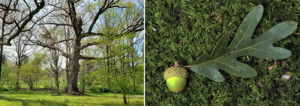
With more than 58 oak species native to North America, there is an oak for every garden, even as our temperatures warm. With a long-lived species like these, when you plant an oak you plant for the future. So if you’re considering bringing one of these iconic trees to your home landscape, it might be worth considering planting one with a slightly more southern range. Some species, like red oak (Quercus rubra) might shift their distribution further north, while more historically Southern species like willow oak (Quercus phellos) may become a more common oak in our landscape. The forests around us will continue to shift and change – this is just one way that we can help plant communities adapt to a warming world. There are also oaks to suit a wide range of garden sizes and styles, from the relatively shrubby bear oak (Quercus ilicifolia), which is hardy up to zone 5, all the way up to the towering white oaks (Quercus alba). If you’re looking to grow paradise, befriend an oak. They are steadfast supporters of the local ecosystem.
Of course, they are not the only tree in the forest. There are so many beautiful trees to be found in the woods of Pennsylvania – and this is one you might not know. Basswood, Tilia americana also called American linden. This elegant tree is an excellent addition to the neighborhood. Its beautiful, creamy yellow flowers appear in June and fill the early summer air with fragrance. It’s the perfect tree to plant if you’re looking to cast shade on a patio and enjoy some fragrant cocktail hours with friends. But even as you sit beneath its shade, the bees above you will be hard at work. You might notice a faint hum around basswood when it flowers. That’s because so many bees visit this tree that the sound of their buzzing can drift down from the branches. If you keep honeybees, or even if you simply enjoy the taste of honey, linden trees are prized for the honey they help produce. Basswood is also a larval plant for both red-spotted purple and mourning cloak butterflies. As the flowers fade, birds and squirrels will visit these trees for the seeds.
Beneath the towering trees of the forest, you’ll find the lower growing shrubs that blanket the stream and hillsides. This layer is crucial; the more layers you have in an ecosystem the more life you can support. So who might you find in this layer of the landscape?
Blueberries, Vaccinium corymbosum is one of North America’s native fruits, but these beautiful bushes do so much more than just give blueberries. Their lovely pink and white flowers are charming in spring, and their fall color brings beauty to the garden in autumn. They like acid soil and grow best in wet, boggy conditions. With blueberries, it’s always a good idea to plant more than one shrub, if only because you’ll have a better chance of getting at least some blueberries before the birds do. The flowers of highbush blueberries also attract both butterflies and native bees, including some species that rely specifically on blueberry plants, like the southeastern blueberry bee (Habropoda laboriosa). This reliance on blueberry bushes is a great adaptation if you are a blueberry plant, as it guarantees that there are pollinators out there looking specifically for your pollen. But it carries some risk for the bee. Planting blueberries is a great way to bring wild native fruit into your diet, but it also helps ensure that these native bees, whose populations are currently in decline, can find the food they need to survive.
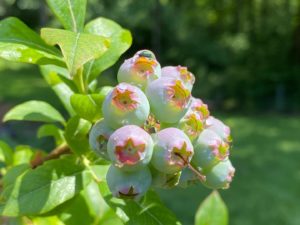
As we saw with oaks, plants can do more than simply support life – they can also improve conditions where they are grown. And one shrub that does this well is New Jersey tea, Ceanothus americanus. New Jersey tea is also one of the few non-legume plants that can fix nitrogen, which gives them – and any plant planted alongside them – an advantage in poor soil. I love this plant because it shows us the way the ecosystem can be self-repairing if we allow the natural cycles to continue. New Jersey tea will help improve the land where it is grown. Its deep, strong roots will reduce compaction, fix nitrogen and help the plant resist fire. Its beautiful, fragrant white flowers bring pollinators into the garden. Butterflies and hummingbirds are frequent visitors. So are bees, wasps, flies, beetles, hairstreak butterflies, azure butterflies and skippers. Birds love these leaves too; both wild turkey and bob-white quail will stop by for a browse of the soft gray-green leaves. New Jersey tea shows us how plants can be our allies in restoration. If we plant them and get them started, we can rely on them to do the silent, unseen work of helping to grow a greener future.
After the shrubs, of course, come the perennials. These faster-growing plants come back year after year, flushing fresh new growth in the spring after they die back down to the ground in the autumn. They play a critical role in the ecosystem, providing food, water and shelter to the life that relies on them. A special one that isn’t often grown in the home garden is wild senna, Senna marilandica. Senna is a beautiful plant, with soft yellow flowers in July and August and brilliant black seed pods in the fall. It is also beloved by pollinators. Interestingly, the flowers don’t actually produce nectar. Instead, they make pollen that is high in protein, making it attractive to many different bees, including bumblebees and sweat bees. Wild senna is also the larval host for three different butterfly species: cloudless sulphur, orange barred sulphur and sleepy-orange butterflies, and come autumn when the plant sets seed they provide food for many bird species, including quail.
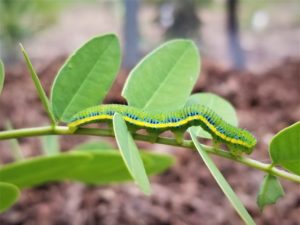
Cloudless sulphur on wild senna
It’s hard to talk about pollinator plants without mentioning this next one – even if people don’t always love it. Goldenrod, Solidago spp. This yellow autumn flower is much maligned for being weedy and for causing seasonal allergies. The good news is that it’s rarely the culprit behind the autumn sniffles and with over 100 species, most native to North America, there is a goldenrod for every garden. One of my personal favorites is stiff goldenrod (Solidago rigida). It stands out from the crowd for a few reasons. Firstly, it thrives in some of the poorest soil out there, from heavy clay to dry sand. On top of that it’s fairly deer and rabbit resistant, likely because its leaves have fine hairs that give the plant an overall silvery color. Stiff goldenrod is an upright plant, like the name would suggest, and reaches about five feet in height and only about two and a half feet in spread. There are few things more evocative of September than the soft, starry flowers of goldenrod. Seeing them bloom in the garden just sets the scene of cool breezes, warm sun and the golden grasses of early fall.
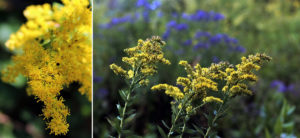
In addition to being a beautiful plant, all goldenrods provide an important pollinator benefit. When they are blooming, most every pollinator seeks them out – bees, wasps, beetles, butterflies and pollinating flies. That’s because when goldenrod blooms many of these pollinators are preparing themselves for the winter, and they desperately need late-season nectar. Monarchs rely on it to prepare them for their long journey back to the Oyamel forests in Mexico, where they overwinter. Goldenrod are mainly pollinated by beetles, but they are a great way to add a reliable nectar source to the landscape for all of our pollinator friends. Their seeds, though diminutive, are eaten by the Eastern goldfinch, so they provide a benefit to our feathered friends as well. We might have a complicated past with this plant – but it’s worth looking at it through new eyes. In the back of the garden, where its height provides a backdrop, the soft yellow flowers of goldenrod can lend beauty to the waning days of fall, and help pollinators prepare for the winter months. Isn’t that what paradise is all about? Learning to co-exist?



